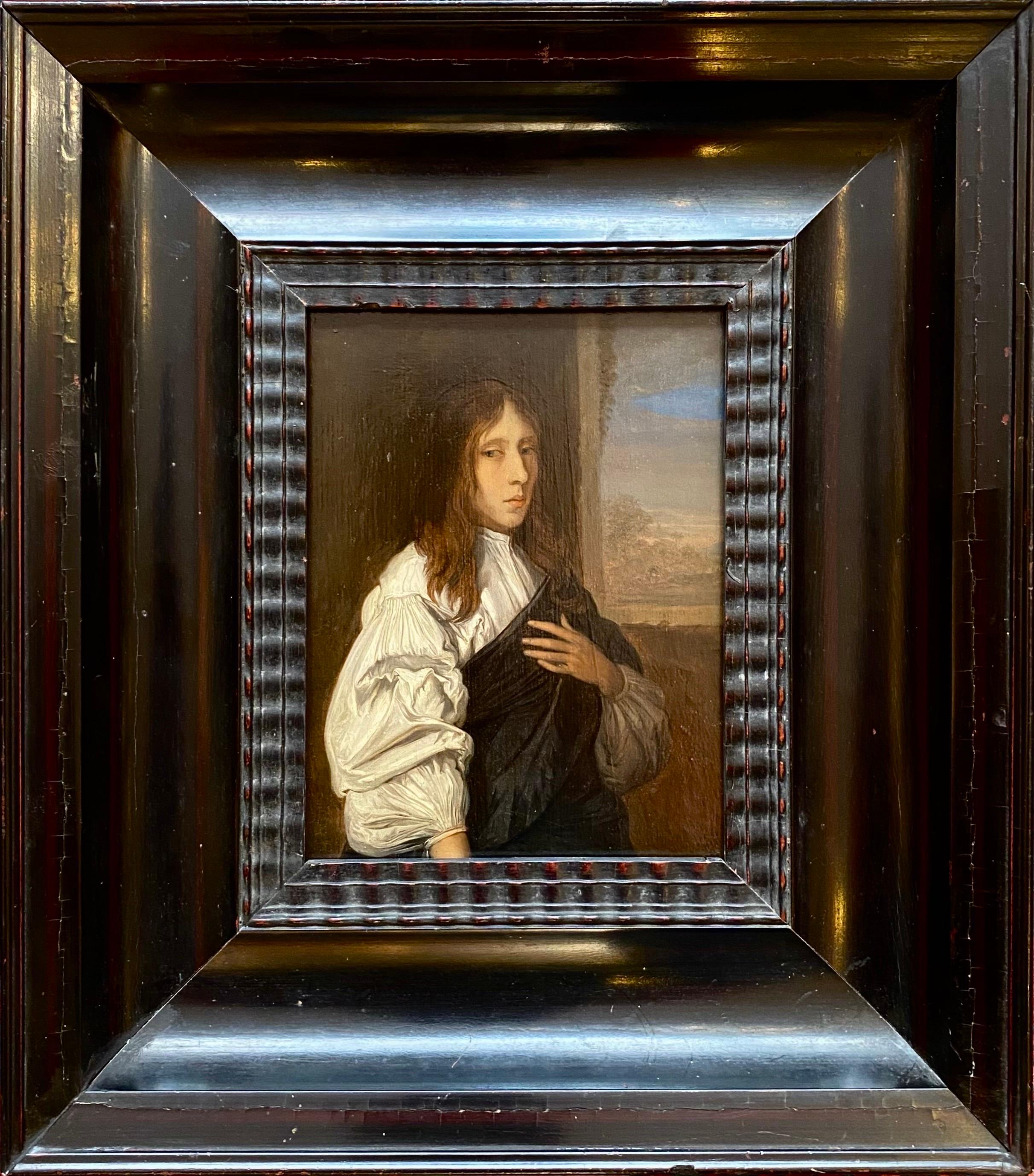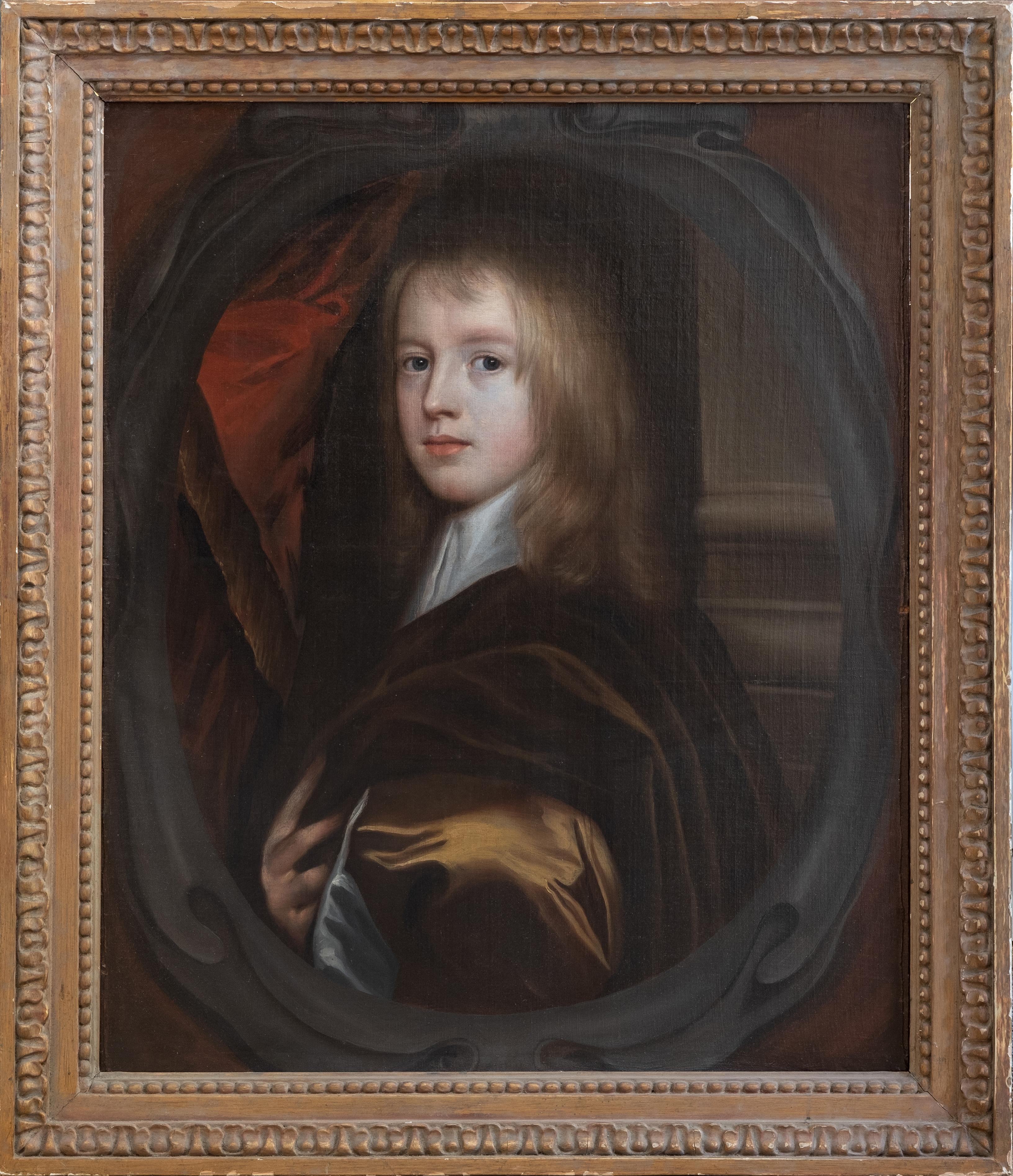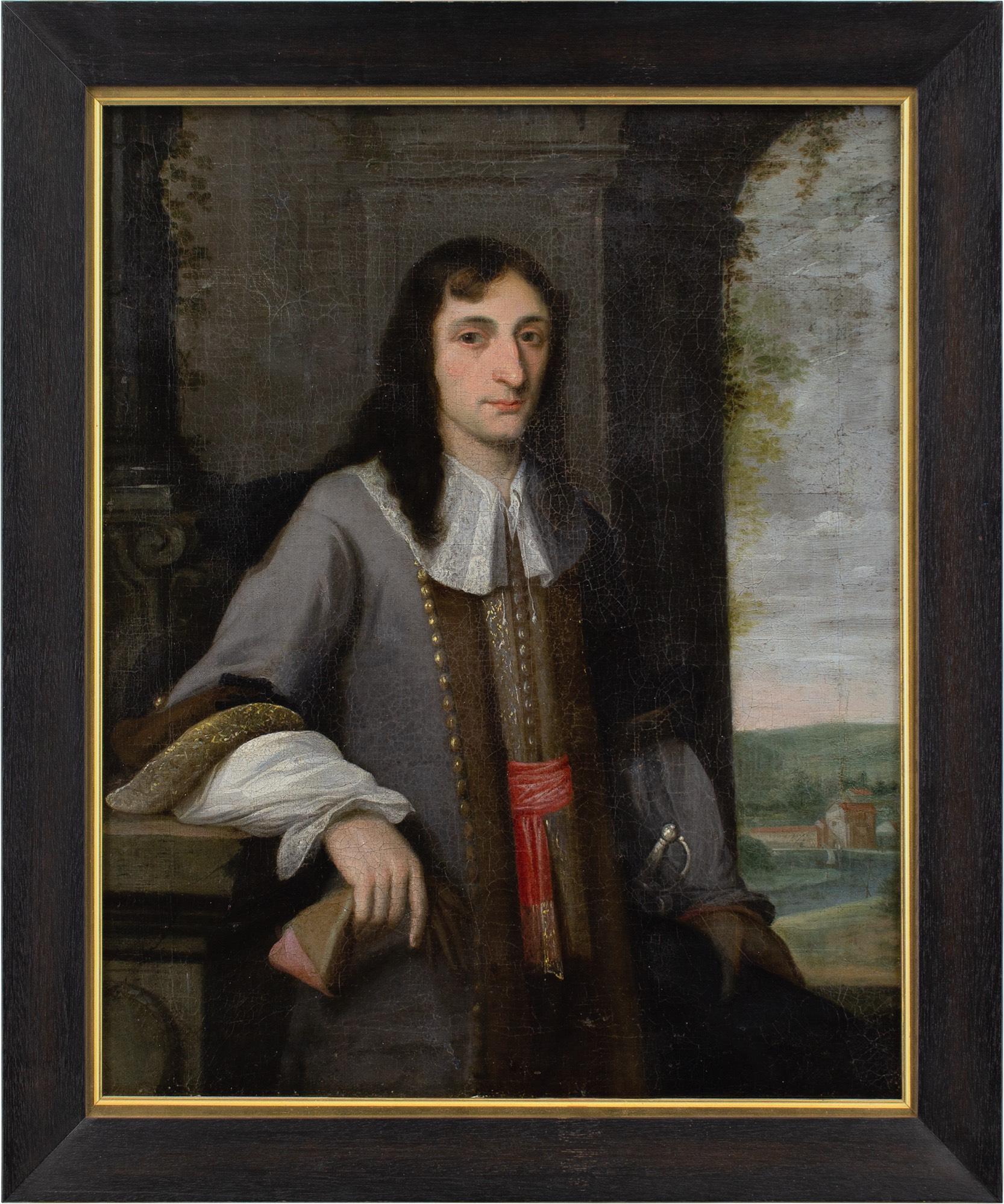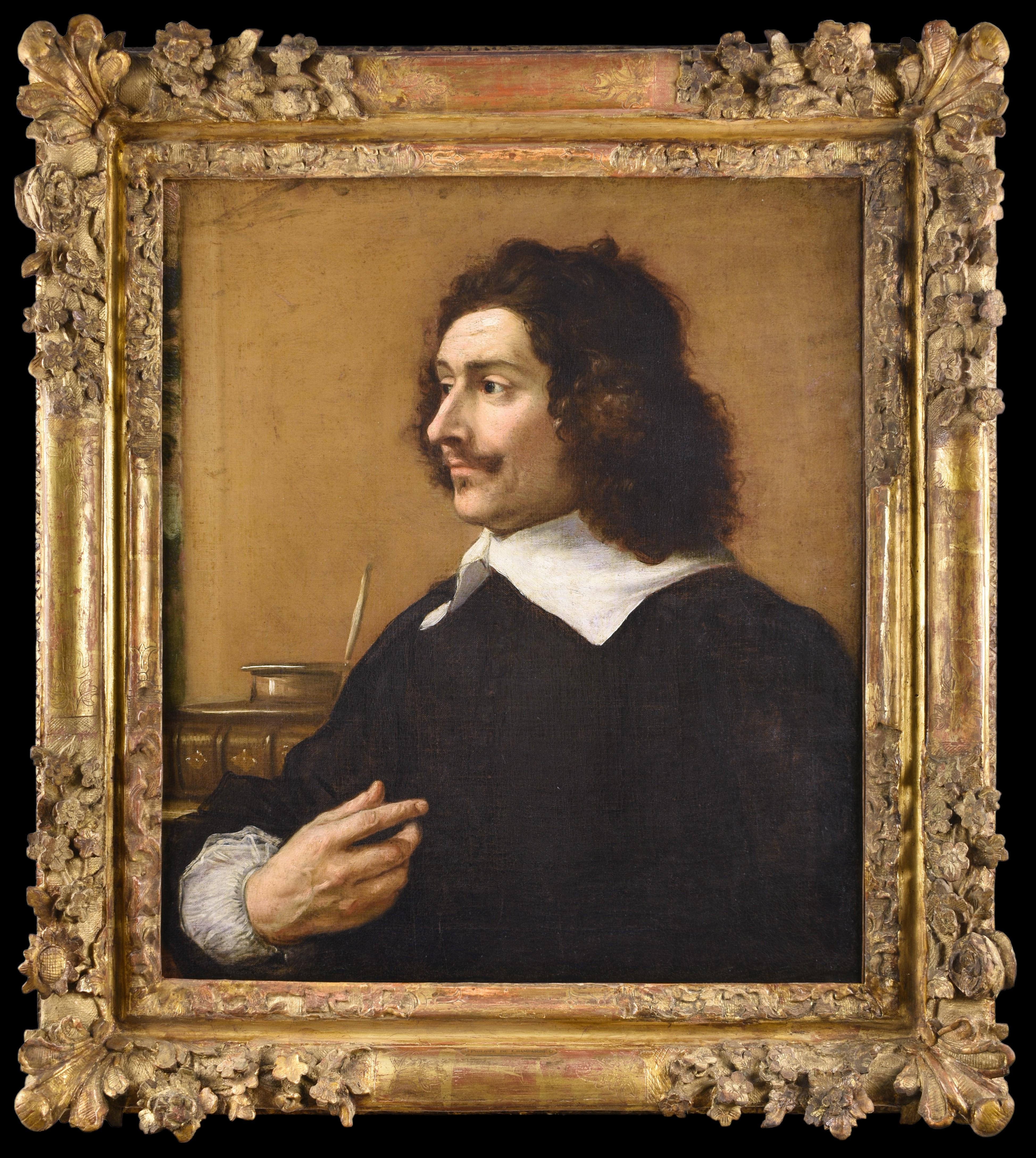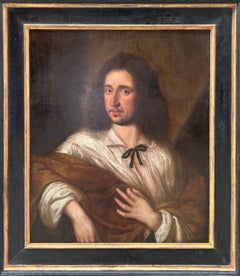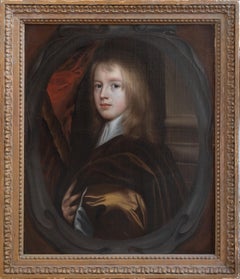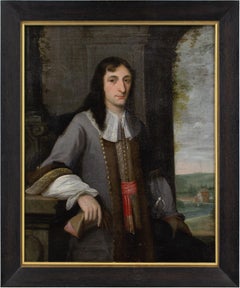Items Similar to Portrait of a Young Man
Want more images or videos?
Request additional images or videos from the seller
1 of 7
Guillaume Courtois known as 'il Borgognone' (Saint Hippolyte 1626 - Rome 1679)Portrait of a Young Man
$16,867.95
£12,220
€14,406.61
CA$23,366.98
A$25,540.95
CHF 13,451.80
MX$314,050.59
NOK 168,110.45
SEK 158,158.75
DKK 107,554.22
About the Item
Oil on canvas
Image size: 13 x 16 1/2 inches (33 x 42 cm)
Contemporary style frame (Image below)
Provenance
Private European Collection
Darnley Fine Art offers this boldly brushed work of a dynamic head study depicts the young man gazing confidently straight out at us. Courtois sets the figure against a light background and uses the play of light across the young man’s form to enhance his physical and psychological character.
Courtois applied paint thinly in the shadows, but accented the face with bold impastos, particularly on the forehead, and merely indicated the man’s hair and clothing with rapid brushstrokes.
The young man is wearing a black doublet, a fitted jacket made popular between the middle ages and the 17th century, worn by everyone from royalty to soldiers.
The work highlights his youthful complexion, as if framed by the white collar while also subtly depicting the young man with a cap on the crown of his head. Headwear was a very important part of male dress in the period, focusing ideas of social and political power, and acting as extensions of the body, connoting authority, rationality, and emphasising the sitters masculinity.
We are grateful to Anna Orlando for confirming the attribution.
Guillaume Courtois, Il Borgognone (Saint-Hippolyte 1628-1679 Rome)
At about age seven, Courtois left France for Italy with his teenage brother. They followed the military campaigns that his brother drew, then studied in Bologna, Florence, and Siena, arriving in Rome by 1638.
He was the brother of the painters Jacques Courtois (Giacomo Cortese) and Jean-François Courtois and was mainly active in Rome as a history painter of Christian religious and mythological scenes as well as a staffage painter, enjoying high-level patronage.
Courtois trained himself by copying Giovanni Lanfranco's and Andrea Sacchi's works and by drawing from nude models. He first studied under Pietro da Cortona, his most important teacher, while painting a fresco in an elegant Roman palazzo in 1656. In the following year he completed his first major public project, two frescoes for a Roman church. They display a strong sense of drama and a more naturalistic approach to the figure than did his later work, which followed the popular classicising manner of Roman late Baroque painting. Courtois made many red chalk studies that demonstrate his great care in preparing the figures for his paintings. He also made composition drawings in pen, ink, and wash.
Courtois is also refereed to as a battle painter due to his involvement in the decorative project in the chapel of the Congregation of the Jesuits in Rome. His work in battle scenes is also evident in his early drawings where he was influenced by his brother Jacques who specialised in battle scenes.
In addition to Courtois' collaborations with his brothers he is also recorded to have worked with the Flemish still life painter Abraham Brueghel who was working in Rome on works such as Still life of fruits and flowers with a figure.
Museums
National Trust, Hinton Ampner
National trust for Scotland, Brodie Castle
Istituto Nazionale per la Grafica
Palazzo Pamphilj
National Museum, Stockholm
Museum Kunstpalast, Dusseldorf
Palace of Nettuno, Florence
Church of San Marco, Venice
Milan, Koelliker Collection
Musée des Beaux-Arts de Besançon
Pinacoteca Capitolina, Rome
Art Institute of Chicago
Museo del Prado, Madrid
Rijksmuseum, Amsterdam
Getty Museum, Los Angeles
Literature
The Getty Museum
Treccani Encyclopedia Institute
Simonetta Prosperi Valenti Rodinò ; published by Gabinetto Nazionale delle Stampe Disegni de Gugliemo Cortese detto il Borgognone. Rome, 1979.
- Creator:Guillaume Courtois known as 'il Borgognone' (Saint Hippolyte 1626 - Rome 1679) (1626 - 1679)
- Dimensions:Height: 16.5 in (41.91 cm)Width: 13 in (33.02 cm)
- Medium:
- Period:
- Condition:
- Gallery Location:London, GB
- Reference Number:1stDibs: LU52414743742
About the Seller
5.0
Vetted Professional Seller
Every seller passes strict standards for authenticity and reliability
Established in 2007
1stDibs seller since 2014
82 sales on 1stDibs
Typical response time: 3 hours
- ShippingRetrieving quote...Shipping from: London, United Kingdom
- Return Policy
Authenticity Guarantee
In the unlikely event there’s an issue with an item’s authenticity, contact us within 1 year for a full refund. DetailsMoney-Back Guarantee
If your item is not as described, is damaged in transit, or does not arrive, contact us within 7 days for a full refund. Details24-Hour Cancellation
You have a 24-hour grace period in which to reconsider your purchase, with no questions asked.Vetted Professional Sellers
Our world-class sellers must adhere to strict standards for service and quality, maintaining the integrity of our listings.Price-Match Guarantee
If you find that a seller listed the same item for a lower price elsewhere, we’ll match it.Trusted Global Delivery
Our best-in-class carrier network provides specialized shipping options worldwide, including custom delivery.More From This Seller
View AllPortrait of a Young Man - 17th Century Portrait in Oil
By Pieter Harmensz Verelst
Located in London, GB
Circle of Pieter Harmensz Verelst
1618 - 1678
Portrait of a Young Man
Oil on oak panel
Image size: 7 ½ x 5 ¾ inches
Dutch ripple frame
Category
18th Century and Earlier Old Masters Portrait Paintings
Materials
Oil, Panel
Portrait of Nicholas Poyntz
Located in London, GB
Remigius Van Leemput
Portrait of Nicholas Poyntz
1607-1675
Oil on oak panel, unsigned
Image size: 13 x 10 1/4 inches (33 x 26 cm)
Contemporary style frame
Provenance
The Dalva Brot...
Category
17th Century Flemish School Portrait Paintings
Materials
Oil, Panel
Portrait of a Melancholic Gentleman, 17th century Oil Painting
Located in London, GB
English School
17th Century
Portrait of a Melancholic Gentleman
Oil on canvas
Image size: 25 x 29 1/4 inches (63.5 x 72.25 cm)
Hand made contemporary style frame
Provenance
South of England Estate
This is a striking 17th century half-portrait of a man. He sits with his body turned to the left and his head to the right. His left hand is held in front of him with thumb and finger together. He wears a loose white shirt that is opened low down onto chest while being closed at his neck with a black ribbon. An orange cloak has also been draped across his arms in a rather dramatic manner.
This choice of costume is immediately notable and must be compared to other portraits of this time of Elizabethan courtiers wearing slashed silk outfits with ostentatious finery and silver swords. Indeed, if one examines 17th century English...
Category
17th Century Portrait Paintings
Materials
Canvas, Oil
Portrait of a Gentleman, 17th Century Dutch Old Masters Oil
Located in London, GB
Circle of Gerard van Honthorst
1592 - 1656
Portrait of a Gentleman
Oil on wooden panel
Image size: 29 x 23 inches
Contemporary gilt frame
Gerard van Honthorst was a Dutch Golden Age...
Category
17th Century Old Masters Portrait Paintings
Materials
Oil, Wood Panel
Portrait of William Herbert, 3rd Earl of Pembroke, Early 17th Century Portrait
Located in London, GB
English School, (circa 1600)
Portrait of William Herbert, 3rd Earl of Pembroke
Oil on panel, oval
Image size: 29¼ x 23⅞ inches
Painted wooden frame
Provenance:
176, Collection of Francis Greville, 1st Earl of Warwick.
The Trustees of the Lord Brooks’ Settlement, (removed from Warwick Castle).
Sotheby’s, London, 22nd March 1968, lot 81.
Painted onto wooden panel, this portrait shows a dark haired gentleman in profile sporting an open white shirt. On top of this garments is a richly detailed black cloak, decorated with gold thread and lined with a sumptuous crimson lining. With the red silk inside it’s all very expensive and would fall under sumptuary laws – so this is a nobleman of high degree.
It’s melancholic air conforms to the contemporary popularity of this very human condition, evident in fashionable poetry and music of the period. In comparison to our own modern prejudices, melancholy was associated with creativity in this period.
This portrait appeared in the earliest described list of pictures of Warwick castle dating to 1762. Compiled by collector and antiquary Sir William Musgrave ‘taken from the information of Lord & Lady Warwick’ (Add. MSS, 5726 fol. 3) is described;
‘8. Earl of Essex – an original by Zuccharo – seen in profile with black hair. Holding a black robe across his breast with his right hand.’
As tempting as it is to imagine that this is a portrait of Robert Devereux, the 2nd Earl Essex, we might take this with a pinch of salt. Its identification with this romantic and fatal Elizabethan might well have been an attempt to add romance to Warwick Castle’s walls. It doesn’t correspond all that well with Essex’s portraits around 1600 after his return from Cadiz. Notably, this picture was presumably hung not too far away from the castle’s two portraits of Queen Elizabeth I. The first, and undoubtedly the best, being the exquisite coronation portrait that was sold by Lord Brooke in the late 1970s and now hangs in the National Portrait Gallery. The second, described as being ‘a copy from the original at Ld Hydes’, has yet to resurface.
The portrait eventually ended up being hung in the State Bedroom of Warwick Castle.
Archival documents present one other interesting candidate. The Greville family’s earliest inventory of paintings, made in 1630 at their home Brooke House in Holborn, London, describes five portraits of identified figures. All five belonged to the courtier, politician and poet Sir Fulke Greville (1554-1628), 1st Baron Brooke, and were hung in the ‘Gallerie’ of Brooke House behind yellow curtains. One of them was described as being of ‘Lord of Pembrooke’, which is likely to have been William Herbert (1580-1630), 3rd Earl of Pembroke. William was the eldest son of Greville’s best friend’s sister Mary Sidney, and was brought up in the particularly literary and poetically orientated household which his mother had supported. Notably, the 3rd Earl was one of the figures that Shakespeare’s first folio was dedicated to in 1623.
The melancholic air to the portrait corresponds to William’s own pretensions as a learned and poetic figure. The richness of the robe in the painting, sporting golden thread and a spotted black fabric, is indicative of wealth beyond that of a simple poet or actor. The portrait’s dating to around the year 1600 might have coincided with William’s father death and his own rise to the Pembroke Earldom. This period of his life too was imbued with personal sadness, as an illicit affair with a Mary Fitton had resulted in a pregnancy and eventual banishment by Elizabeth I to Wilton after a short spell in Fleet Prison. His illegitimate son died shortly after being born. Despite being a close follower of the Earl of Essex, William had side-stepped supporting Devereux in the fatal uprising against the Queen and eventually regained favour at the court of the next monarch James I.
His linen shirt is edged with a delicate border of lace and his black cloak is lined on the inside with sumptuous scarlet and richly decorated on the outside with gold braid and a pattern of embroidered black spots.
Despite the richness of his clothes, William Herbert has been presented in a dishevelled state of semi-undress, his shirt unlaced far down his chest with the ties lying limply over his hand, indicating that he is in a state of distracted detachment. It has been suggested that the fashion for melancholy was rooted in an increase in self-consciousness and introspective reflection during the late 16th and early 17th centuries.
In contemporary literature melancholy was said to be caused by a plenitude of the melancholy humor, one of the four vital humors, which were thought to regulate the functions of the body. An abundance of the melancholia humor was associated with a heightened creativity and intellectual ability and hence melancholy was linked to the notion of genius, as reflected in the work of the Oxford scholar Robert Burton, who in his work ‘The Anatomy of Melancholy’, described the Malcontent as ‘of all others [the]… most witty, [who] causeth many times divine ravishment, and a kind of enthusiamus… which stirreth them up to be excellent Philosophers, Poets and Prophets.’ (R. Burton, The Anatomy of Melancholy, London, 1621 in R. Strong, ‘Elizabethan Malady: Melancholy in Elizabethan and Jacobean Portraits’, Apollo, LXXIX, 1964).
Melancholy was viewed as a highly fashionable affliction under Elizabeth I, and her successor James I, and a dejected demeanour was adopted by wealthy young men, often presenting themselves as scholars or despondent lovers, as reflected in the portraiture and literature from this period. Although the sitter in this portrait is, as yet, unidentified, it seems probable that he was a nobleman with literary or artistic ambitions, following in the same vain as such famous figures as the aristocratic poet and dramatist, Edward de Vere...
Category
Early 17th Century Old Masters Portrait Paintings
Materials
Oil, Wood Panel
Portrait of an Officer, Cornelius Johnson, 17th Century Old Masters
By Cornelius Johnson
Located in London, GB
Circle of Cornelius Johnson
Circa 1620’s
Portrait of a Officer
Oil on canvas
Image size: 28 x 24 inches
Period style hand made frame
Provenance
Private European Estate
This striking portrait dates to around 1620, as you can see from the images of the sash the detail is very high. The sash is decorated with gold thread and would have cost a small fortune at the time. Sashes were originally developed for a military function (making officers more visible for their men during combat), but soon became a primarily male fashion...
Category
Early 17th Century Old Masters Portrait Paintings
Materials
Oil
You May Also Like
Portrait of a Young Gentleman - Dutch Old Master 17thC art portrait oil painting
Located in Hagley, England
This superb Dutch Old Master portrait oil painting is attributed as by a follower of Dutch 17th century artist Gerrard van Honthorst. The original of this painting hangs in Wilton House, Wiltshire, home to the 18th Earl and Countess of Pembrokeshire. The painting was previously attributed to Van Dyck by early cataloguers, but after exhaustive comparisons with the two Honthorst brothers' works, it was concluded that Gerrard van Honthorst was the artist who painted the original in Wilton House. Our painting was painted circa 1695 by a follower of Gerrard Honthorst. It was sold to us as circle of Cornelius Johnson.
The sitter is Prince Rupert of the Rhine, Duke of Cumberland, Earl of Holderness (1619-1682). He was an English army officer, admiral, scientist, and colonial governor. He first came to prominence as a Royalist cavalry commander during the English Civil War. Rupert was the third son of the German...
Category
1650s Old Masters Portrait Paintings
Materials
Oil
Portrait of a Young Boy - British art 1780 Old Master male portrait oil painting
By Joseph Wright of Derby
Located in Hagley, England
This lovely Old Master portrait oil painting is attributed to the circle of Joseph Wright of Derby. Painted circa 1780 the painting is of a boy in a tunic and wide collar. A really c...
Category
18th Century Old Masters Portrait Paintings
Materials
Oil
$8,558 Sale Price
20% Off
17th Century Oil Painting Portrait of a Young English Boy
By Gerard Soest
Located in London, GB
Gerard SOEST (1600 - 1681)
Portrait of a Young Boy
oil on canvas
35.5 x 30.5 inches inc. frame
Gerard Soest (circa 1600 – 11 February 1681), also known as Gerald Soest, was a portra...
Category
17th Century Old Masters Portrait Paintings
Materials
Oil
17th-Century Flemish School, Portrait Of A Gentleman In A Justaucorps
Located in Cheltenham, GB
This fine late 17th-century Flemish portrait depicts a distinguished gentleman wearing a justaucorps, black cloak, white shirt, vest, leather gloves, and breeches. He’s carrying a wi...
Category
1670s Old Masters Portrait Paintings
Materials
Oil, Canvas
Portrait of a Nobleman, French School 17th Century
Located in New York, NY
French portrait of a nobleman, 17th Century, great condition. With a beautiful carved wooden frame.
Category
17th Century Baroque Portrait Paintings
Materials
Canvas, Oil
17th Century Italian Oil Painting Portrait of Music Prodigy Girolamo Frescobaldi
Located in London, GB
Portrait of Girolamo Frescobaldi (1583-1643)
Attributed to Antiveduto Della Grammatica (1571-1626)
Oil on Canvas
1605-1609
Framed in a Nineteenth Century gild and composite frame
44....
Category
Early 17th Century Baroque Figurative Paintings
Materials
Oil
More Ways To Browse
17th Century Saint Paintings
Scotland Castles
Scottish Castle
Roman Baroque Painting
Kate Moss Painting
Powdered Wigs
Warhol Studio 54
Woman Smoking Art
1800 Oil Painting Portrait
Abe Lincoln
Hollis Dunlap
Indian Girl
John Winston
Oil Painting Of King George V
Oil Portraits Of Fisherman
Pompeo Batoni
Princess Diana Art
Swedish Oil Portrait
